
* The F-16 has been continually improved since its introduction and still continues to improve. This chapter provides a description of F-16 variants.
* The F-16A and F-16B were built in a series of production "blocks", consisting of Blocks 1, 5, 10, and 15. The first three blocks featured only minor changes. Block 1 featured a black nose radome and nose RWR antenna cover, which made the aircraft too easy to spot and recognize, so Block 5 went to a gray radome and RWR antenna cover. Block 10 featured minor internal changes, such as modified wiring. Block 1 and Block 5 aircraft were brought up to Block 10 spec from 1982 through 1988.
Incidentally, although traditionally block numbers were designated by a suffix to an aircraft's normal designation, for example "F-16A-15", for whatever reasons the Air Force refuses to use this format, and always refers to an "F-16A Block 15". The more compact form is a useful "shorthand", but it's not officially approved. There are also "sub-blocks" or "miniblocks", such as "Block 50A", "Block 50B", and so on, but since these only refer to minor changes they will not be detailed in this document.
* The Block 15 F-16A/B featured more significant changes, implemented as part of a "Multinational Staged Improvement Program (MSIP)". Block 15 was the first phase of the MSIP effort, and was also referred to as "MSIP I". The major visible change was a new tailplane that featured a rear extension that gave it 30% more area. The new "big tail" improved stability, and permitted faster take-off rotation, as well as flight at higher angles of attack. Other changes included improvements to the AN/APG-66 radar, installation of a new "Have Quick" secure radio, and a modified cockpit instrument layout.
At the end of Block 15 production, an "Operational Capability Upgrade (OCU)" was introduced that featured the improved P&W F100-PW-220 engine, which was fitted with:
Production moved to the Block 15 OCU F-16 in 1988. Most earlier aircraft in service were updated to the same specification.
In the early 1990s, a "Mid-Life Upgrade (MLU)" program was begun to upgrade F-16A/Bs to modern standards. The Block 15 MLU upgrade featured:
These improvements were originally introduced in post-Block-15 F-16 production, as discussed later. Several hundred Dutch, Belgian, Danish, and Norwegian machines were updated beginning in 1995, with slight differences in kit for each nation. The USAF had helped set up the program, but withdrew.
BACK_TO_TOP* In the early 1990s, 24 Block 10 F-16As were modified for the close air support (CAS) role for the New York State Air National Guard by being wired to carry a 154-kilogram (339-pound) "GPU-5/A Pave Claw" centerline cannon pod, built around the General Electric "GAU-13/A" 30-millimeter cannon. The GAU-13/A was a four-barreled version of the huge GAU-8/A Avenger six-barreled Gatling cannon used on the Fairchild A-10 Warthog close-support aircraft.
Apparently the Pave Claw pod was never entirely satisfactory, since it wasn't properly integrated with the aircraft fire-control system, and it also tended to jitter around on the stores pylon too much, ruining accuracy. These CAS machines fought in the Gulf War in 1991 but apparently did not use the Pave Claw cannon in combat, and they were phased out after the war in favor of newer F-16 variants. The Air Force had been under pressure at one time to field a dedicated CAS version of the F-16, the "A-16", with increased armor and the Pave Claw pod -- but the USAF has always been ambivalent about the CAS role, and managed to avoid obtaining such a specialized variant.
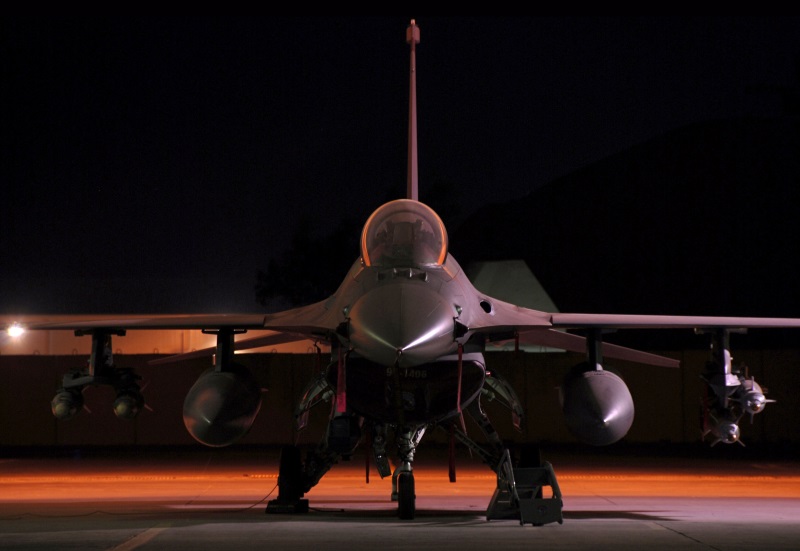
* In the late 1980s, at least 241 Block 15 F-16A/B machines were converted to an "Air Defense Fighter (ADF)" configuration for US Air National Guard (ANG) squadrons. The ADF F-16 was optimized as an interceptor for air defense of North America and featured:
The ADF machines retained Block 15 ground attack capability. They could be distinguished by a row of four blade antennas, for the IFF system, just in front of the windscreen. There was a proposal to fit the ADF machines with oversized 2,271-liter (600 US gallon) drop tanks and a brake chute, but the standard 1,400-liter (370 US gallon) drop tanks were retained and no chute was fitted.
* In the 1990s, years after the end of F-16A/B production, a variant similar to the Block 15 MLU was produced for Taiwan. Block numbers of F-16 production had moved well on by that time, but these Taiwanese machines were given the "Block 20" designation since that block number had been skipped over. The Block 20 designation was also at least informally applied to the European Block 15 MLU machines as well. Later production F-16A/Bs used the rear fuselage and wing of the Block 50 F-16, described later.
BACK_TO_TOP* The Block 15 OCU variant of the F-16A/B was designed to bring older aircraft up to roughly comparable effectiveness with higher-numbered F-16 blocks. Disregarding the out-of-sequence Taiwanese Block 20, the next higher block number was "Block 25". Block 25 embodied Phase II MSIP modifications and involved enough changes to justify new variant designations -- in the form of the "F-16C" single-seater and the "F-16D" two-seater.
Oddly, the most recognizable external difference between the F-16A/B and F-16C/D ended up being more or less pointless. The bottom section of the tailfin was made wider, forming a "pedestal" for the top section, in order to accommodate an "Advanced Self Protection Jammer (ASPJ)" that would eliminate the need to carry an external jamming pod, but the ASPJ program was canceled.
More useful improvements in the Block 25 F-16C/D included:
Initial flight of a Block 25 F-16C was on 15 June 1984, followed by the first flight of a Block 25 F-16D on 14 September.
* The next step beyond the Block 25 was the "Block 30". The major change in this subvariant was support of the new GE F110-GE-100 bypass jet engine. The GE F110 was an improved version of the GE F101 engine evaluated in the F-16/101, using a low-pressure compressor and afterburner modeled on those used with the smaller GE F404 bypass jet engine fitted to the F/A-18 Hornet.
The Block 30 F-16C/D was in principle designed to accommodate either a P&W F100 or a GE F110 engine using a "common engine bay" -- but in practice it wasn't exactly that simple. The GE F110 was somewhat bigger and heavier than the P&W F100, and provided about 22.2 kN (2,267 kgp / 5,000 lbf) more thrust. The GE F110 required a bigger engine inlet to accommodate greater airflow, but that airflow was too much for the P&W F100, and so F-16s with the different engines had different inlets. The inlet was modular and relatively easily swapped out. GD had major problems with the inlet design with their earlier F-111 strike fighter, and were careful to make sure they didn't repeat that mistake. Apparently some modifications had to be made in the engine bay as well.
Other improvements in the Block 30 F-16 included:
Since fitting an F-16 with a GE F110 or P&W F100 engine was not an entirely trivial process and inescapably posed some complications for maintenance and the parts pipeline, the Air Force tended to segregate F-16s at the wing level by engine type. The Block 30 fitted with a P&W F100-PW-220 engine was actually assigned a "Block 32" designation. Block 30 and Block 32 were identical, except for the engine fit and its associated tweaks. It appears that the GE-powered Block 30 had a clear performance edge on the P&W-powered Block 32.
First flight of an F-16C Block 30 was on 12 June 1986, while first flight of an F-16D Block 30 was on 30 July 1986. The first flight of a Block 32 F-16C and F-16D was on 12 June. The USAF Thunderbirds flight demonstration team received stock Block 32s, modified only by fitting them with smoke generators; the Air Force wanted to be able to put them in combat if need be.
* The US Navy decided to acquire a small batch of F-16C Block 30s modified for the land-based aggressor training role and given the designation "F-16N". These machines lacked cannon, being ballasted to maintain flight trim, with space left over in which a pilot could throw a carry bag or the like; they could simulate firing the cannon. They also lacked much of the other combat avionics, though they did retain AN/APG-66 radar. In service, they generally flew with a captive AIM-9 Sidewinder training round on one wingtip, and an "Air Combat Maneuvering Instrumentation (ACMI)" unit on the other wingtip; ACMI wasn't carried on flight ranges that didn't support it.
The F-16Ns also featured the General Electric F110-GE-100 afterburning bypass jet engine instead of the P&W F100, had reinforced wings to support high-gee maneuvers, and were fitted with radar "corner reflectors" attached to each side of the engine inlet to make them more visible on radar.
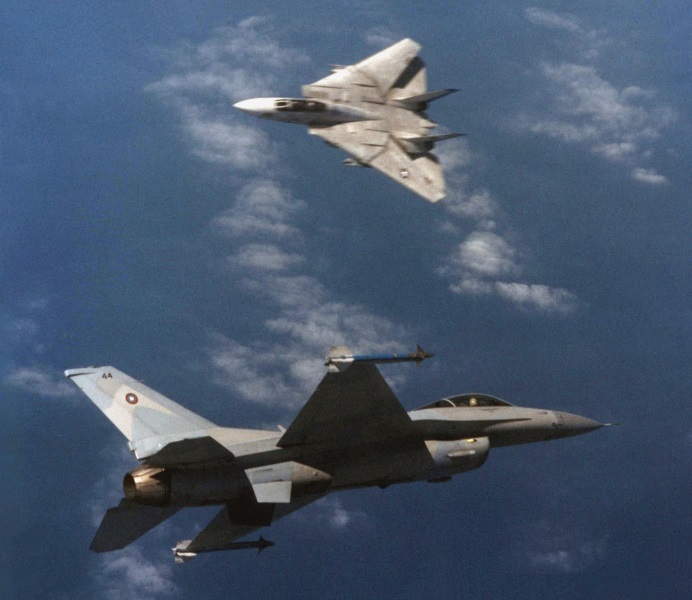
22 F-16Ns were delivered to the US Navy in 1987 and 1988, along with 4 two-seater "TF-16N" conversion trainers. At least one F-16N was painted in a spiffy blue "splinter" camouflage color scheme imitating that of the Russian Sukhoi Su-27 Flanker. The F-16Ns didn't have much in the way of teeth -- but given that they were very lightly-loaded, they were apparently great fun to fly. They were real "hot rods" compared to frontline combat F-16s, able to break Mach 1 at altitude unintentionally, without afterburner.
They proved expensive to operate and aggressor combat training was de-emphasized in the 1990s, mostly for cost reasons, but possibly also because simulators provided a partial solution. Apparently, the F-16Ns were nearing the end of their service lives as well. The F-16N aggressor squadron was disbanded in 1994 and the F-16Ns were retired in 1995, ending up in mothballs.
In the next decade, the US military began to refocus on aggressor training. As a result, in 2003 the Navy obtained 14 Block 15 OCU F-16A/Bs, including 8 F-16As and 4 F-16Bs, from an order to Pakistan that had been embargoed, returning the F-16 to the Navy aggressor role. Obviously, these machines were trimmed and kitted up for the aggressor role. From 2022, the Navy acquired 26 more Vipers from the Air Force, including 20 single-seat Block 32 F-16Cs and six two-seat Block 25 F-16Ds.
The USAF has similarly operated the F-16 in the aggressor role, most notably with the 64th Aggressor Squadron (AGRS) out of Nellis AFB in Nevada. The 64th AGRS moved up in 1988 from Northrop F-5Es to flying loaned F-16As, pending the arrival of F-16C/D machines in 1989. The 64th AGRS was disbanded in 1990; again, that was reconsidered, with the squadron re-established in 2003. At last notice, it was flying 24 F-16s. The Air Force has operated other F-16 aggressor units elsewhere -- but it's a shifting landscape, and hard to follow their history and current status.
BACK_TO_TOP* The Block 40 & Block 42 F-16 retained the same engine fits as the Block 30/32, but featured a set of enhancements mainly intended to improve the F-16's night strike capabilities. The Block 40/42 subvariant was sometimes referred to as the "Night Falcon".
The main enhancement for the night attack role was support of the "Low Altitude Navigation & Targeting Infrared for Night (LANTIRN)" pod set. LANTIRN consisted of two pods mounted under the engine intake, including an AN/AAQ-13 "navigation pod" and an AN/AAQ-14 "targeting pod". The navigation pod included terrain-following radar, a wide-angle "forward looking infrared (FLIR)" video camera, and a digital processor system. The targeting pod included a steerable narrow-angle FLIR camera and a laser / rangefinder unit for laser-guided bombs.
LANTIRN gave the Night Falcon the ability to fly to and hit targets at night using laser-guided bombs (LGBs), with navigation assisted by support for a GPS-INS unit. A new digital flight-control system worked in conjunction with LANTIRN to provide terrain-following capability.
LANTIRN had actually been planned as far back as Block 15, which introduced the capability to mount the inlet stores attachments, though it wasn't used at the time. One of the rationales for the "big tail" introduced in that block was the need to aerodynamically compensate for the sensor pods on the inlet. Other changes to the Block 40/42 included:
Incidentally, weight creep meant that the Block 40/42's performance was slightly inferior to earlier blocks, but that was more than compensated for by its increase in capability. In general, the Block 40/42 was regarded as substantially more capable than any previous variant.
Initial flight of the F110-powered Block 40 F-16C was on 23 December 1988, with initial flight of the Block 40 F-16D on 8 February 1989. Initial flight of the F100-powered Block 42 F-16C was on 25 April 1989, followed by the initial flight of the Block 42 F-16D on 26 May 1989.
* The Air Force was not entirely happy with the weight growth and performance decline of the Block 40/42, and so the next subvariant, the "Block 50/52", was not optimized for the night attack role and featured new, more powerful, GE and P&W "Improved Performance Engines (IPE)".
The Block 50 was fitted with the GE F110-GE-129 IPE and the Block 52 was fitted with the P&W F100-PW-220 IPE. Both engine variants had 129 kN (13,150 kgp / 29,000 lbf) afterburning thrust, 20% more than the original-fit F100-PW-220 bypass turbojet, and were much more powerful in low-level flight than previous models. With the IPE variant, the F100 finally caught up to F110 performance.
Some early production Block 52 machines were temporarily retrofitted with the older F110-PW-220, due to bugs in the new engine variant. The F100-PW-229 IPE featured a distinctive gloss-black exhaust not used in the GE F110 or earlier P&W F100 variants. Some Block 40/42s were refitted with IPE engines.
The Block 50/52 also featured AN/APG-68(V)3 radar with improved reliability and signal processing capabilities plus more modes; a new, lighter, cheaper HUD; and an "Improved Data Modem" datalink. The new block included the digital flight capability and features the HUD of the Block 30/32, but added the digital flight control system, reinforced airframe, and stronger landing gear of the Block 40/42.
Initial flight of an F110-powered Block 50 F-16C was on 22 October 1991, with first flight of a Block 52 F-16D following on 1 April 1992. First flight of an F100-powered Block 52 F-16C was on 22 October 1992, with first flight of a Block 52 F-16D on 24 November 1992.
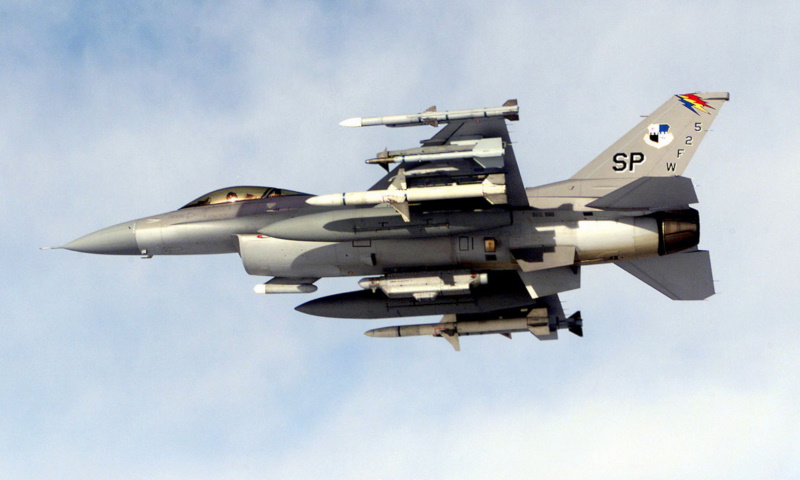
* Nothing was changed on the Block 50/52 to rule out carriage of LANTIRN, but as far as the USAF was concerned, that was a job for the Block 40/42. Some Block 50/52 machines were capable of carrying the Texas Instruments "AN/ASQ-213 HARM Targeting System (HTS)" to give them a "suppression of enemy air defenses (SEAD)" capability. The HTS was a small pod carried on the right side of the engine inlet to allow an F-16 to detect, identify, and target adversary radar and other emitters for attack with the aircraft's AGM-88 HARM missiles. They were given the special designation of "F-16CJ/DJ".
"Wild Weasel" defense suppression aircraft were traditionally two-seat machines, such as the McDonnell Douglas F-4G Wild Weasel Phantom the Block 50/52 with HTS replaced, and some critics claimed the single-seat F-16C with HTS was an inadequate replacement. Defenders countered that improved data processing and software allowed a single-seat aircraft to perform the mission perfectly well.
In early 2005, the Air Force gave the go-ahead for an upgrade to the HTS, allowing several F-16s to "network" their HTS pods over a "Link-16" digital datalink system. This upgrade was to provide enhanced accuracy -- enough to provide targeting coordinates to a GPS-guided munition -- and also greater range. Although the HTS pod was originally mounted on the right inlet stores pylon, the upgrade relocated it to the left inlet stores pylon to free up the right pylon for a targeting pod. The upgrade automatically slewed the targeting pod's imager system to the location identified by the HTS. The modernized aircraft were redesignated "F-16CM/DM".
* The USAF became reliant on the F-16 and has expended considerable effort on keeping the type up to date. One of the first major upgrade programs was the billion-dollar "Common Configuration Implementation Program (CCIP)", pronounced "see-sip", to bring what would be a total of 562 Block 40/42/50/52 F-16s up to a common improved specification program. The CCIP upgrades included:
The first two CCIP F-16s were redelivered in the fall of 2003, with the baseline program completed in 2010. There were relatively minor follow-on updates to the CCIP, generally oriented towards software upgrades and so easily deployed -- with a focus on support of the latest munitions, but also improving overall system integration with added smarts. Those who developed the F-16 could have had little clue at the time that it would increasingly acquire intelligence beyond what they could have imagined.
In the meantime, the USANG and USAF Reserve updated 113 Block 25 and 319 Block 30/32 F-16s under "System Capability Upgrade 7 (SCU-7), which featured support for the "Helmet-Mounted Integrated Targeting (HMIT)" sight, a cheaper alternative to JHMCS; new radios, including satcom support; a glass cockpit; and improved targeting pod support.
These upgrades have been followed by enhancements to software and new munitions carriage. The Air Force also added an "automatic ground collision avoidance system (Auto-GCAS)" to the USANG fleet, this system keeping track of the terrain and automatically pulling up to avoid flying into the ground if the pilot didn't heed warnings.
In parallel with the technical upgrades, the US F-16 fleet has been run through an ongoing "service life extension program (SLEP)" as time accumulates on their airframes, with the SLEP providing structural refurbishment to make sure they can keep on flying. The SLEP increases the airframe life from its original 8,000 flight hours to almost 14,000 flight hours.
BACK_TO_TOP* In 1993, Lockheed bought out the Fort Worth division of General Dynamics, a move which was part of a series of corporate reshufflings that led to the merger of Lockheed and Martin Marietta in 1995 to form "Lockheed Martin". As a result, the "General Dynamics F-16" became the "Lockheed Martin F-16". Lockheed Martin acquired a valuable asset with the F-16 and has continued to refine the type. One of the features of a good combat aircraft is its suitability for improvement, and the F-16 continued to be improved in the 21st century, starting with the F-16E/F "Block 60".
At least part of the roots of the Block 60 F-16 were in a mid-1990s Lockheed Martin investigation of an "F-16ES (Extended Strategic)" variant for Israel. An F-16C that had been used as a GE F110 demonstrator was further modified as the F-16ES demonstrator, performing its first flight in November 1994 and conducting a series of test flights into early 1995.
The F-16ES demonstrator was fitted with large dummy "conformal fuel tanks (CFTs)" that fitted over the wing roots back to the tail, as well as FLIR camera blisters on the top and bottom of the nose. Production conformal fuel tanks were to give the F-16ES an unrefueled combat radius with warload of 1,600 kilometers (1,000 miles). The test flights demonstrated that the tanks had surprisingly little impact on the aircraft's handling.
* The Israelis opted for the F-15I Eagle instead, and the F-16ES demonstrator was demodified back to a more-or-less normal F-16 spec. However, the CFT scheme had been validated, and Lockheed Martin kept it in mind.
In the mid-1990s, the United Arab Emirates (UAE) had come forward with a requirement for 80 long-range strike fighters. Lockheed Martin originally responded with a plan for a delta-winged F-16 variant -- something of a follow-on to the F-16XL described later -- but finally decided on a more conservative approach, basically the F-16ES with improved avionics. The concept aircraft was originally referred to as the "Block 60". The CFTs were the most visible change from tradition, but the Block 60 also featured improved avionics. Two blisters were fitted on the nose for an "internal forward looking infrared and targeting system (IFTS)" to provide targeting for air or ground targets, as well as a target designation capability.
More significantly, the Block 60 featured the AN/APG-80 radar, an "AESA (Active Electronically Scanned Array)" radar with three times the range of any radar fitted to a current F-16. Instead of a conventional antenna, it featured an array of "transmit-receive (T/R)" modules that cooperate to operate as a "smart" antenna that can perform multiple functions at once. The AESA radar also provided frequency hopping and other techniques for "low probability of intercept" operation, meaning that the radar could often detect a target without the target's electronic warnings systems becoming aware of being scanned. Improved defensive countermeasures were added as well. The Block 60's systems were integrated with high-speed processing capability and were under control of a state-of-the art "glass cockpit" with three large color flat-panel multifunction displays.
The UAE accepted the Lockheed Martin proposal and ordered the 80 Block 60s in 1998, rejecting competing proposals including the Eurofighter and the Dassault Rafale. The Block 60 F-16 was seen as having comparable capability while being basically a mature system, and deliveries would be faster. With the changes dictated for the UAE Block 60 machines, their configuration eventually became distinctive enough to justify a new designation of "F-16E/F".
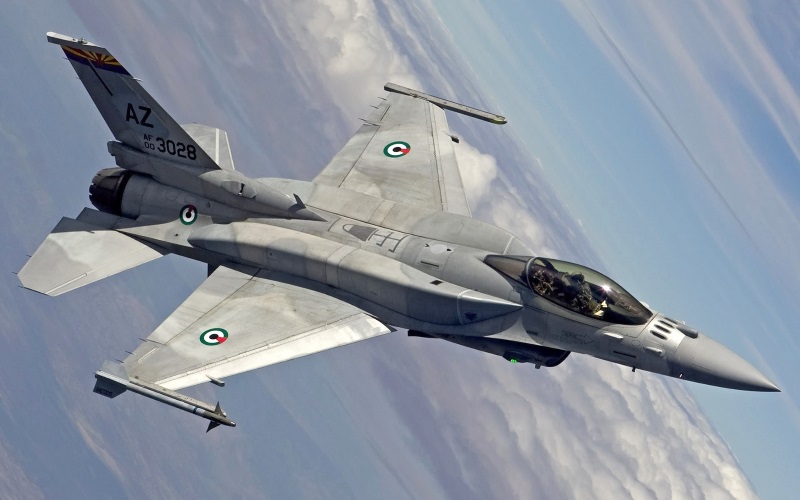
* The Israelis obtained a Block 60-class machine as the "F-16I", with an advanced non-AESA AN/APG-68(V)9 radar and some other changes in avionics, and Singapore obtained F-16s to a similar specification. Several customers, including Greece, Chile, and Poland, obtained the "Advanced Block 50/52" or "Block 50/52 Plus" variant, which featured CFTs but retained most of the avionics of the Block 50/52. They could be distinguished from the "classic" Block 50/52 by the lack of FLIR kit forward of the cockpit on the nose. The UAE obtained a "Block 61", it seems much the same as the Block 60 but with the latest avionics, including an AESA radar.
Incidentally, in response to a fighter requirement from India, Lockheed Martin collaborated with Hindustan Aerospace LTD (HAL) of India, Israel Aerospace Industries (IAI), and Flight Refueling LTD (FRL) of the UK to develop a "Conformal Aerial Refueling Tanker System (CARTS)" to allow the F-16 to be flight-refueled with a hose-drogue system. CARTS was based on a modified right CFT with a retractable refueling probe. It was demonstrated at the Farnborough Air Show in the UK in 2010, but Lockheed Martin didn't win the India fighter deal, and nothing more was said about CARTS.
* The 4,500th F-16 was delivered in 2012. With Lockheed Martin refocused on delivering the "F-35 Joint Strike Fighter (JSF)", the F-16 became a lower priority for the company -- but it hasn't been abandoned. New features such as vectoring engine nozzles to improve maneuverability, stealthy exhausts and engine inlets, and other improvements have been considered to make the aircraft more effective.
Lockheed Martin has flight-tested an "infrared search & track (IRST)" system, the "Legion" pod, which would allow an F-16 to spot and track "stealthy" targets by their infrared signature. The Air Force is very interested in the IRST, as a tool to keep their existing fighter assets effective for a longer time.
More significantly, Northrop Grumman developed a lightweight, relatively low-cost AESA radar for the F-16 designated the "AN/APG-83 Scalable Agile Beam Radar (SABR)", based on the F-35's AN/APG-81. SABR was designed to be affordable and also compatible with legacy radars in terms of form factor, power consumption, and cooling requirements.
Lockheed Martin is now producing the "F-16V" -- "V" for "Viper" -- AKA "Block 70/72", essentially a Block 60 with SABR radar, a new "Center Pedestal Display", and other updated kit. Initial flight of the F-16V prototype was in October 2015, with the initial flight of the first production machine, a two-seater with "fat spine" for Bahrain, in January 2023. Along with new production, the F-16V also represented an upgrade package that F-16 users could obtain in full or in part.
Along with a number of foreign users, the USAF is now committed to an F-16V-style upgrade program. In 2017, the Air Force awarded Northrop Grumman a contract to refit 72 Air National Guard F-16Cs with SABR radar, with the work to begin in late 2018. That was a stepping stone to a much more ambitious update effort to update 608 F-16s in Air Force service, featuring SABR radar, CPD, and mission computer, improved communications including a Link-16 datalink, and advanced electronic warfare system. The EW suite will be built around "AN/ALQ-254(V)1 Viper Shield", a digital system with software configuration, integrated with the AESA system, plus an internally-fitted self-protection jammer, and new towed decoy.
BACK_TO_TOP* There were a number of unusual and dead-end variants of the F-16, plus some machines specially modified for test purposes.
In 1980, just as the numbers of F-16s were beginning to build up in operational units, GD began work on a cheaper version of the fighter for the export market, to be powered by the older General Electric J79 afterburning turbojet. The Carter Administration didn't want to export first-line US fighters, and promoted an "Export Fighter" or "FX" competition to select a candidate for the role. The competitors were the GD "F-16/79" and the Northrop "F-5G", later the "F-20 Tigershark".
No funding was provided by the US government, but the winner could look forward to large numbers of international sales with the government's blessing. Sales of a thousand aircraft were anticipated. GD rebuilt the one of the FSD machines, an F-16B, for use as a prototype, fitted with a new variant of the J79, the "J79-GE-17X", optimized for fit in the F-16 and with increased thrust. The J79 was longer, required less airflow, and ran hotter than the P&W F100 engine. GD fitted a 46-centimeter (18-inch) plug to the exhaust to accommodate the increased length, fitted a modified engine inlet with a wedge-shaped lip at the top to adjust the airflow, and installed a steel heat shield around the rear of the engine. Adding the heat shield resulted in a significant increase in aircraft weight.
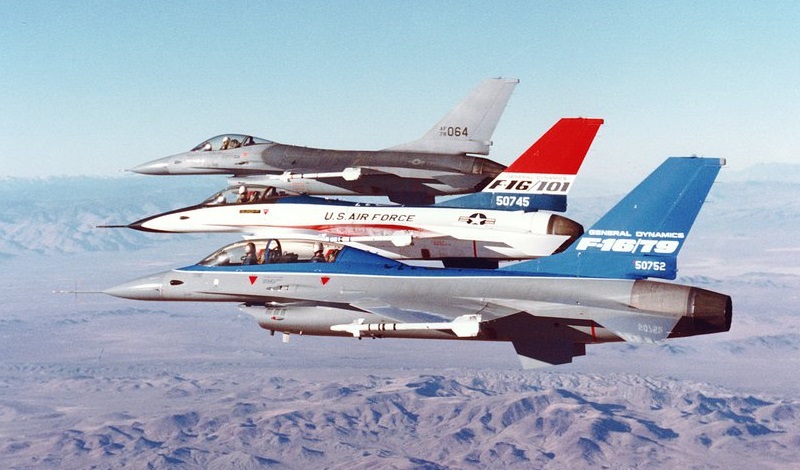
The F-16/79 prototype performed its initial flight on 29 October 1980. Although it was test flown for over a year, customer reactions were not highly positive. When GD got the green light to sell proper F-16s to American allies, the F-16/79 effort was quietly dropped and forgotten. The machine was then refitted with a P&W F100, redesignated "F-16B-2", and put to extensive use as a trials aircraft. One test pilot said that the F-16B-2 was fitted with "bits and pieces of every F-16C/D ever made, and a lot of pieces that have never been in another F-16."
* In December 1975, the first YF-16 prototype was converted by the USAF Flight Dynamics Laboratory into an aerodynamic testbed to investigate "decoupled" flight, meaning maneuvering in one plane without having to move in another. An example would be turning without banking.
The "Control Configured Vehicle (CCV)" YF-16 featured twin pivoting ventral fins under the engine intake and a modified FBW flight control system. It performed its first flight on 16 March 1976, and performed test flights to July 1977. The test program was cut short by a hard landing, though the aircraft was repaired and used for tests of a full-cockpit escape pod. It is now on static display at the Hampton Roads History Center in Hampton Roads, Virginia, and has been restored to its initial YF-16 prototype configuration.
The CCV program was judged successful, and led to a more ambitious follow-on effort, in the form of the "Advanced Fighter Technology Integration (AFTI)" F-16, which was conducted in collaboration with the US National Aeronautics & Space Administration (NASA). The AFTI F-16 was a modification of the sixth FSD F-16A, which had been previously fitted with a "big nose" and flown in trials of the AN/APG-65 radar used on the F/A-18 Hornet.
The AFTI F-16 featured ventral fins under the engine intake as with the CCV YF-16, plus a triple redundant digital FBW system (in contrast to the analog FBW system of the standard F-16), and a dorsal spine to house additional gear. Initial flight of the AFTI F-16 was on 10 July 1982, and the machine went on to a long career as a flight test machine.
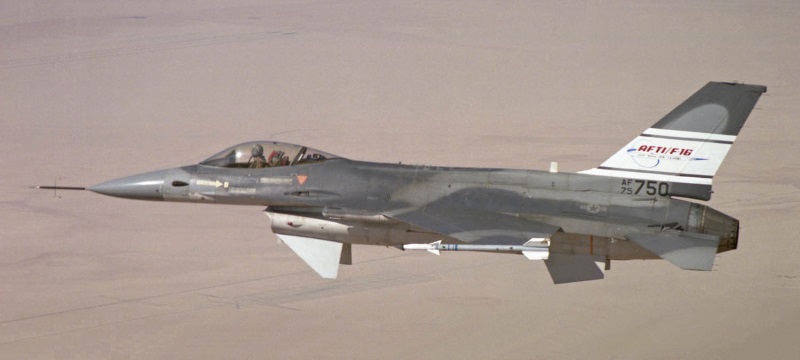
After the initial flight dynamics series of tests, in 1988 the aircraft went to be used for experiments in close air support, becoming the "AFTI/CAS" F-16. The AFTI/CAS F-16 featured such items as voice-command input and twin "bugeye" infrared sensors, cluttering up the nose of the aircraft in front of the canopy. The forward ventral fins were removed.
The AFTI F-16 in its various forms was used in a total of ten separate test programs, performing hundreds more flights before being retired in early 2001. It was flown by pilots from the USAF, the US Marine Corps, the Swedish Air Force, Lockheed Martin, General Dynamics, and NASA. The AFTI F-16 is now in the possession of the US Air Force Museum in Dayton, Ohio.
* One of the most interesting and distinctive variants of the F-16 was the "F-16XL" or the "Supersonic Cruise And Maneuvering Prototype (SCAMP)", which featured a "double-delta" wing configuration something like that of the Swedish SAAB 35 Draken fighter. The wing had a span of 10.03 meters (32 feet 5 inches) and an area of 62 square meters (663 square feet). The F-16XL also had a fuselage stretch of 1.42 meters (4 feet 8 inches), and the ventral fins were deleted.
The new wing had been designed in cooperation with the NASA, which collaborated with GD on the project. The wing featured graphite-epoxy top and bottom panels to reduce weight, and gave the F-16XL twice the payload capacity of the F-16A. There was a total of 29 stores stations, including centerline and two inlet stations as on the F-16C/D, four recessed stations for AMRAAM missiles, nine stations under each wing, and wingtip launch rails for Sidewinder AAMs.
The fuselage stretch gave the F-16XL 40% more range. The ventral fins were deleted. The rear fuselage was canted up by three degrees to increase the angle of attack on take-off and landing, and a brake chute compartment was fitted to reduce landing roll.
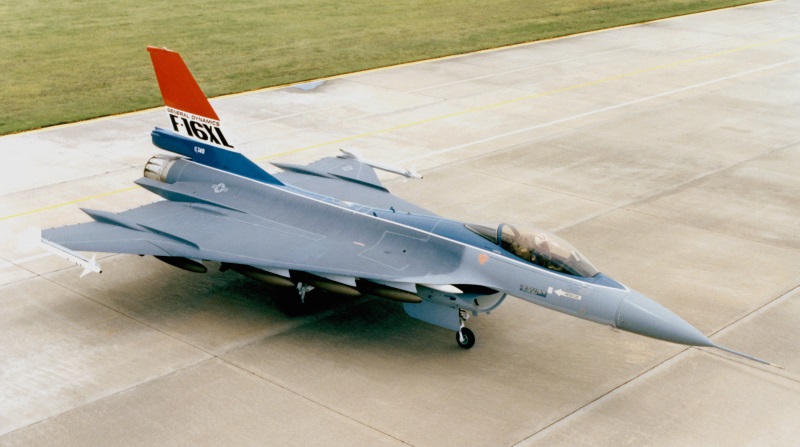
Two F-16XLs were rebuilt from the FSD single-seat F-16As, with a single-seater F-16XL built from the fifth FSD and a two-seater built from the third FSD machine. The two-seater was also fitted with a GE F110 engine. The single-seater was known as the "F-16XL" or "F-16E", while the two-seater was known as the "F-16XL-2" or "F-16F".
The single-seat F-16XL performed its initial flight on 15 July 1982 and was initially used to evaluate "supersonic cruise" performance, in which a fighter would be able to sustain supersonic flight without use of afterburner. The F-16XL was not quite able to reach this goal. The two-seat F-16XL performed its first flight in October 1982. It was evaluated for an Air Force long-range attack requirement to replace the General Dynamics F-111, but the McDonnell Douglas F-15E Strike Eagle was selected instead in 1984.
The two F-16XLs ended up in the hands of NASA, being used for aerodynamics studies by the NASA Dryden center. They were fitted with modified wings and other aerodynamic refinements. Boeing later proposed an extensive remodeling of one of the F-16XLs to test a "low sonic boom" configuration, with the modified aircraft featuring a longer nose, a spike behind the tailfin with a tailplane, wingtip extensions, and other changes. NASA was intrigued, but didn't have the money to fund it.
* In the early 1990s, one Block 30 F-16D was modified to test a digital flight control system that allowed it to imitate, in principle and within limits, the performance of other aircraft. This machine was known as the "NF-16D Variable stability Inflight Simulator Test Aircraft (VISTA)", and made its first flight in its VISTA form on 9 April 1992. It actually featured a center-mounted stick along with the sidestick controller. The VISTA effort was funded by the USAF, US Navy, and NASA.
In 1993, the NF-16D was modified to test out a thrust-vectoring engine nozzle, being given the new designation "NF-16D Multi-Axis Thrust Vectoring (MATV)". It was also given a fat spine for test avionics, and performed its first flight in this configuration on 2 July 1993. After completion of the MATV test program in late 1994, the NF-16D was returned to its VISTA configuration for other flight trials. In 2021, the VISTA NF-16D was redesignated "X-62A", to be modified again and put to use in the "Skyborg Autonomy Control System" effort, focused on developing a highly intelligent robot pilot.
* Ideas had been floated from the late 1990s on using old high-time F-16As as modernized target drones, with such thinking emerging in 2010 in the form of a contract to Boeing for remanufacture of "QF-16" target drones. These machines provide a realistic modern target for training; they are optionally piloted. A total of up to 126 conversions is planned, the first conversion being delivered to the USAF for evaluation in 2012, the first unmanned flight in late 2013, production machines being delivered from the spring of 2015, and introduction to service in the fall of 2016. There was thought of fitting F-16 target with surplus J79 engines, leveraging off the work for the F-16/79 effort, but the QF-16s retained the F100 powerplant.
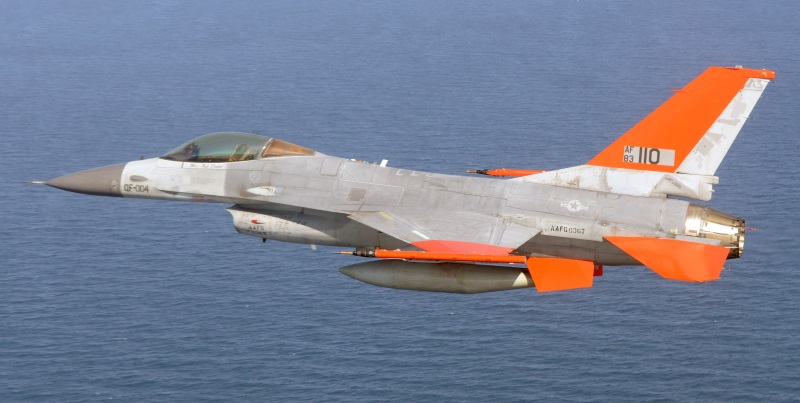
* There were a number of other F-16 variants that never flew. During the YF-16 evaluation, GD backed a Ling-Temco-Vought (LTV) proposal for a navalized derivative of the F-16 for the US Navy's "Navy Air Combat Fighter (NACF)", which was to replace the F-4 Phantom and the Vought A-7. The "LTV Model 1600", as it was designated, was to feature stronger landing gear and arresting hook for carrier landings; wingtip launch rails for Sparrow AAMs and launch rails along the engine intake for Sidewinder AAMs; plus various avionics kit as required by the Navy. Several engine fits were considered. The Navy opted for the McDonnell Douglas F/A-18 instead, and the navalized F-16 never even reached the mockup phase.
One interesting unbuilt variant was a design for an F-16A with forward-swept wings (FSW). The idea was proposed for a US Defense Advanced Research Projects Agency (DARPA) study in the late 1970s. DARPA selected a custom FSW design, the Grumman "X-29", for the project instead.
Other unbuilt variants included a short take-off / vertical landing (STOVL) variant, and an "Agile Falcon" that would feature a wing with 25% greater wing area. The Agile Falcon concept would actually be more or less realized when Japan decided to built their own variant of the F-16, the Mitsubishi F-2, discussed later.
Another interesting proposal promoted by Lockheed Martin was for an attack drone or "Uninhabited Combat Aerial Vehicle (UCAV)", based on updates of old F-16A/B airframes. These machines would be converted to robot operation, with the cockpit removed and faired over, and fitted with a wing about twice the span of a normal F-16 wing, littered with stores pylons. The idea was to use them for "air occupation", loitering over a battle theater for long periods of time to pounce on anything that moved.
The US Air Force and Navy chose to work on new attack drone designs instead. However, the idea didn't go away, with the Air Force Research Laboratory (AFRL) conducting "Loyal Wingman / Have Raider" tests from 2015, in which a robot F-16 -- using robot avionics from the QF-16, but enhanced with true combat capabilities -- flew as a "wingman" to a piloted F-16. The idea was that the pilot could use the robot F-16 as an auxiliary asset, possibly as a diversion; or provocation of adversary defenses; or for secondary strikes. In late-phase trials, the robot F-16 was able to autonomously conduct simulated strikes and deal with simulated air defenses, while its communications were cut off.
That led to the X-62A / Skyborg effort. From 2023, leveraging off the Skyborg effort, six stock F-16s were updated with robot flight control systems under the "Viper Experimentation & Next-Gen Operations Mode (VENOM)" as a step towards the USAF's "Collaborative Combat Aircraft (CCA)" program, which envisions future air combat as a collaboration between piloted aircraft and unpiloted loyal wingman robot combat aircraft.
BACK_TO_TOP* The F-16's most characteristic weapon is the AIM-9 Sidewinder AAM, usually carried on the wingtip launch rails. Most US machines traditionally carried the AIM-9L/M all-aspect variants, but some foreign users had to settle for the slightly less sophisticated AIM-9P-4 variant. A few users have qualified AAMs from other nations, such as the Israeli Rafael Python or French Matra Magic series of heatseeking AAMs, both in the same class as the Sidewinder.
The F-16 now generally carries the AIM-9X AAM and sometimes the comparable British "Advanced Short Range AAM (ASRAAM)". Both of these are "off-boresight" AAMs, meaning they don't have to be pointed directly at the target before launch. They are instead "cued" to the target by the pilot's helmet-mounted sight.
Along with the Sidewinder, F-16 have also carried the medium-range AIM-7M Sparrow -- though only a few nations acquired this weapon for the F-16 -- but more importantly acquired Sparrow's much-improved follow-on, the AIM-120 AMRAAM. There are rumors that some foreign F-16s have been qualified for the French Matra MICA AAM.
* As discussed earlier, although the F-16 was initially designed as a lightweight air combat fighter, it was originally tasked in USAF service as a strike aircraft, and accordingly qualified for standard iron bombs and cluster munitions. It is certainly possible for an F-16 to carry other "dumb" munitions such as napalm tanks and 70-millimeter (2.75 inch) unguided rocket pods, but these seem to be relatively unusual stores. US F-16s have been known to have carried Durandal runway-buster bombs.
No doubt dumb bombs and such are still carried by the F-16, though cluster munitions have generally gone out of style. The world's air forces have been migrating towards smart weapons, however, and US F-16s now generally carry guided weapons, such as laser-guided bombs (LGBs) or AGM-65 Maverick guided missiles, with the LGBs guided by LANTIRN pods. Other targeting pods are in use by some foreign air forces, such as the Thales "Damocles" pod, and the Israeli Rafael "Litening" pod. A variant of the Litening pod is even used by some USANG F-16s. The Air Force has acquired the Lockheed Martin "Sniper" pod, in its series of improved variants, to replace LANTIRN.
Interestingly, LGB targeting pods seem to be often carried by single-seat F-16s, though flying an airplane in the face of enemy defenses while trying to keep crosshairs on a target sounds a bit tricky. Modern targeting pods are smart enough to maintain target lock automatically. F-16s did carry electro-optic guided bombs (EOGB) such as the GBU-15 glide bomb, which required carriage of an AN/AXQ-14 datalink pod -- but the EOGBs are now largely out of service.
Block 50/52 machines with the HARM Targeting System also carry the AGM-88 HARM, and the Block 50/52 has been qualified to carry the AGM-84 Harpoon antiship missile. Foreign users also carry their own stores. For example, Norwegian F-16s carried the Penguin Mark 3 antiship missile, and Israeli F-16s have carried the big Rafael "Popeye" electro-optic guided standoff missile.
F-16s have been qualified to use modern US guided weapons, including the "Joint Direct Attack Munition (JDAM)" GPS-guided bomb; the "Small Diameter Bomb (SDB)" GPS-guided bomb, and the much improved "SDB II" with a multi-mode seeker; the "Joint Stand-Off Weapon (JSOW)" glide bomb; and the "Joint Air To Surface Standoff Missile (JASSM)" cruise missile.
* F-16s have been adapted to the reconnaissance role, carrying a range of reconnaissance pods. In 1986, an F-16D was modified into a more optimized reconnaissance configuration, carrying a multisensor bathtub-style pack on the centerline. The pack was big enough to make ground clearance minimal. This experimental fit was at least informally referred to as the "RF-16D", and labeled "F-16 Recce" (pronounced "recky") on its tailfin. Nothing came of this experiment.
In the mid-1990s, after almost giving up on the tactical reconnaissance mission, the Air Force decided to try again to give the F-16 a reconnaissance capability, with the reconnaissance mission to be handed to the USANG. Lockheed Martin developed a prototype pod, the "Electro-Optical 1 (EO-1)" with a digital camera controlled by a laptop computer. This led to the production of four interim pods known only as the "Richmond recce pod", with a digital camera, magnetic-tape recorder, and a GPS receiver to help log image coordinates. The Richmond recce pod saw service in the Balkans. It was replaced by the definitive "AN/ASD-11 Tactical Airborne Reconnaissance System (TARS)", with a number of improvements. All three of these pods are carried on the centerline station.
From 2017, the F-16 has been evaluated with the Northrop Grumman "AN/ASQ-236", which is an AESA synthetic aperture radar unit, intended for all-weather ground surveillance. It was previously fielded on the F-15E Strike Eagle. The pod's precise capabilities remain classified. It is unclear if there is any intent to field it on the F-16.
The USAF has flown their F-16s with external jammer pods, usually mounted on the centerline pylon, with the aircraft initially carrying the AN/ALQ-131 pod. The current USAF jammer pod is the Raytheon AN/ALQ-184(V)9, which can carry four Raytheon AN/ALE-50 towed decoys. As discussed later, several foreign users have selected their own countermeasures suites. The Per Udsen company in Denmark has come up with a tidy "Pylon Integrated Dispenser System (PIDS)", which fits chaff-flare dispensers to the rear of the outboard stores pylon on each wing. PIDS is in service with a number of foreign user as well as the USANG and USAF Reserve, and the company has now developed a "PID+" with missile warning capabilities.
One of the more usual external stores carried by the F-16 is the "MXU-48" cargo pod, which is used to carry the pilot's personal effects and other gear when the fighter is being deployed to a new base.
BACK_TO_TOP